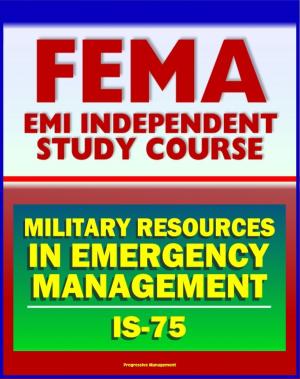Hypersonic Global Strike Feasibility and Options: Design Challenges, Propulsion, Fuel, Material, Plasma Interference and Weapons Employment, Current Programs, Weapons Integration, X-37B, AHW
Nonfiction, Science & Nature, Technology, Aeronautics & Astronautics, History, Military, Aviation| Author: | Progressive Management | ISBN: | 9781311729354 |
| Publisher: | Progressive Management | Publication: | April 3, 2016 |
| Imprint: | Smashwords Edition | Language: | English |
| Author: | Progressive Management |
| ISBN: | 9781311729354 |
| Publisher: | Progressive Management |
| Publication: | April 3, 2016 |
| Imprint: | Smashwords Edition |
| Language: | English |
Professionally converted for accurate flowing-text e-book format reproduction, this unique book examines the feasibility of hypersonic weapons and aircraft as global strike options in the 2035 timeframe. The paper proposes there are currently two limitations or gaps in U.S. prompt global strike capabilities; timeliness, and increasingly the ability to gain access to the highly-defended target area. Additionally, the USAF has a long history of using advanced technology to stay ahead of the threat defense systems and gaining access to target sets, and by 2035, anti-access and area denial (A2/AD) technologies will increasingly threaten the USAF ability to hold any target on the globe at risk. Therefore, given the fact that technologies will continue developing to diminish and deny the advantages of stealth and space assets, could speed once again allow access to denied, heavily defended targets and close the gap for prompt global strike by 2035?
The analysis begins with a brief overview of past hypersonic programs and reveals the lack of coherent government policy or USAF confidence in future military utility for hypersonic weapons or aircraft. The paper explores evidence that recent developments in threat radars along with future predictions for processing power and passive detection techniques will diminish the inherent advantages of stealth. Additionally, the Long Range Strike (LRS) family of systems, most likely the main global strike option in 2035, does not provide a prompt global strike solution, and a subsonic bomber could still be denied entry to some future A2/AD environments. After a thorough operational analysis of future concepts and a look at the current advances in hypersonic technology, this paper concludes there are feasible military missions for hypersonic cruise missiles and aircraft in the 2035 timeframe. Hypersonic missiles and strike or reconnaissance aircraft could fold into the LRS family of systems; providing deterrence, prompt conventional global strike, HDBT attack, and critical ISR missions in A2/AD environments.
Introduction * History of Hypersonic Research * A Day Without Stealth? * A Day Without Space? * Advantages to Hypersonic Vehicles: Operational Analysis * Operational Analysis Conclusions * Design Challenges for Hypersonic Vehicles * Propulsion and Fuel Challenges * Material Challenges * Plasma Interference and Weapons Employment Challenges * Cost Challenges * Current Hypersonic Programs Overview * HTV-2, X-37B, and AHW * Conclusions and Recommendations * OA, Weapons Integration, and Sensors * Materials, Propulsion and Fuels * Final Thoughts * Appendix A: Long Range Strike Family of Systems * Appendix B: Operational Analysis * Appendix C: Cost Analysis * Bibliography * Footnotes
Professionally converted for accurate flowing-text e-book format reproduction, this unique book examines the feasibility of hypersonic weapons and aircraft as global strike options in the 2035 timeframe. The paper proposes there are currently two limitations or gaps in U.S. prompt global strike capabilities; timeliness, and increasingly the ability to gain access to the highly-defended target area. Additionally, the USAF has a long history of using advanced technology to stay ahead of the threat defense systems and gaining access to target sets, and by 2035, anti-access and area denial (A2/AD) technologies will increasingly threaten the USAF ability to hold any target on the globe at risk. Therefore, given the fact that technologies will continue developing to diminish and deny the advantages of stealth and space assets, could speed once again allow access to denied, heavily defended targets and close the gap for prompt global strike by 2035?
The analysis begins with a brief overview of past hypersonic programs and reveals the lack of coherent government policy or USAF confidence in future military utility for hypersonic weapons or aircraft. The paper explores evidence that recent developments in threat radars along with future predictions for processing power and passive detection techniques will diminish the inherent advantages of stealth. Additionally, the Long Range Strike (LRS) family of systems, most likely the main global strike option in 2035, does not provide a prompt global strike solution, and a subsonic bomber could still be denied entry to some future A2/AD environments. After a thorough operational analysis of future concepts and a look at the current advances in hypersonic technology, this paper concludes there are feasible military missions for hypersonic cruise missiles and aircraft in the 2035 timeframe. Hypersonic missiles and strike or reconnaissance aircraft could fold into the LRS family of systems; providing deterrence, prompt conventional global strike, HDBT attack, and critical ISR missions in A2/AD environments.
Introduction * History of Hypersonic Research * A Day Without Stealth? * A Day Without Space? * Advantages to Hypersonic Vehicles: Operational Analysis * Operational Analysis Conclusions * Design Challenges for Hypersonic Vehicles * Propulsion and Fuel Challenges * Material Challenges * Plasma Interference and Weapons Employment Challenges * Cost Challenges * Current Hypersonic Programs Overview * HTV-2, X-37B, and AHW * Conclusions and Recommendations * OA, Weapons Integration, and Sensors * Materials, Propulsion and Fuels * Final Thoughts * Appendix A: Long Range Strike Family of Systems * Appendix B: Operational Analysis * Appendix C: Cost Analysis * Bibliography * Footnotes















